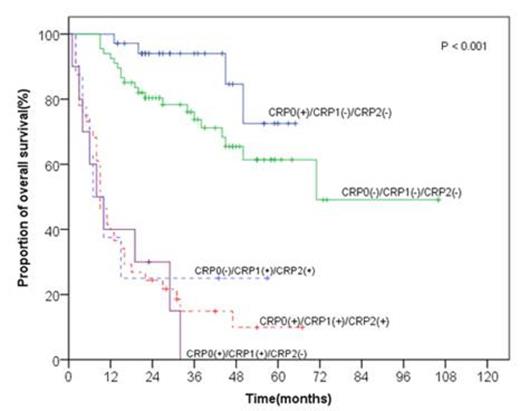Abstract
The prognostic value of dynamic monitoring C-reactive protein (CRP) serum levels in NK/T-cell lymphoma
C-reactive protein (CRP) is a kind of acute phase protein against inflammatory reaction. CRP has been proved to be associated with prognosis in various malignancies. Yet, the prognostic value of CRP in natural killer/T-cell lymphoma (NK/TCL) remains to be discussed. In this study, we aimed to observe the dynamic change of CRP serum levels during anti-lymphoma treatment, and to evaluate the prognostic value of CRP as a simple and economical biomarker during the early stage of treatment in patients with NK/T-cell lymphoma.
Between January 2003 and December 2011, 161 patients with newly diagnosed NK/TCL at the Sun Yat-sen University Cancer Center (SYSUCC) were reviewed retrospectively. Clinical and laboratory information was collected and analyzed. The following CRP serum levels were evaluated: pretreatment CRP (CRP0), early-treatment CRP (CRP1, after one cycle of chemotherapy, or two or three weeks since beginning of radiation), and post-treatment CRP (CRP2, after first-line treatment, or failure of first-line treatment).
Overall, 161 patients were reviewed and analyzed. The median age was 44 years (range, 11¨C74). The majority had localized disease (stage I/ II; 75.5%). The CRP serum levels (mean ± standard deviation) were as follows: CRP0, 17.2±23.1 mg/L; CRP1, 14.0±30.0 mg/L; CRP2, 14.1±27.0 mg/L. The pretreatment CRP serum levels correlated with others unfavorable factors, including serum lactate dehydrogenase (LDH) (P = 0.005), presence of bulky disease (P = 0.002), presence of B symptoms (P = 0.017), the International Prognostic Index (IPI) score (P = 0.001) and the Korean Prognostic Index (KPI) score (P = 0.001). By the time of the final follow up assessment (May 2013), the median follow-up time was 23.0 months (range, 1.0-106.0 months). The median overall survival (OS) and progression-free survival (PFS) were 45.0 months (range, 1.0-106.0 months) and 32.0 months (range, 1.0-74.0 months), respectively. The independent unfavorable prognostic factors for OS (P < 0.05) in multivariate analysis included: elevated CRP1 (P < 0.001), presence of bulky disease (P = 0.007), and elevated β2-microglobulin (β2-mg) serum levels (P = 0.004). The receiver operating characteristic analysis revealed a similar cut-off value of CRP (8.16 mg/L) to the default value of the biochemical analyzer (8.2 mg/L). In addition, the result suggested a satisfying capacity of CRP1 in predicting response to initial treatment (sensitivity 94%, specificity 74%) and 5-year OS (sensitivity 75%, specificity 90%), among different serum biomarkers, including EBV-DNA, LDH, β2-mg, CRP0, CRP1, and CRP2. In all groups of patients classified according to dynamic CRP values, the patients with CRP0 (+) /CRP1(-) presented the most favorable prognosis (5-year estimated OS: 72.5%).
Our study suggests that elevated early-treatment CRP is an independent unfavorable prognostic factor for patients with NK/TCL. Compared with the baseline CRP, the dynamic change of CRP levels may provide more important information for prognosis during treatment.
Patient proportion and survival according to subgroups of CRP serum levels
| Groups . | CRP serum levels . | . | Patients . | Median PFS . | Median OS . | 2-y PFS . | 5-y OS . | |||
|---|---|---|---|---|---|---|---|---|---|---|
| . | CRP0 . | CRP1 . | CRP2 . | . | n . | % . | (months) . | (months) . | (%) . | (%) . |
| Group 1 | + | - | - | 35 | 21.7 | Not reached | Not reached | 82.3 | 72.5 | |
| Group 2 | - | - | - | 67 | 41.6 | 31 | 71 | 57.5 | 61.4 | |
| Group 3 | + | + | + | 41 | 25.5 | 6 | 9 | 49.0 | 9.9 | |
| Group 4 | + | + | - | 10 | 6.2 | 6 | 8 | 0 | 0 | |
| Group 5 | - | + | + | 8 | 5.0 | 4 | 7 | 0 | 0 | |
| Groups . | CRP serum levels . | . | Patients . | Median PFS . | Median OS . | 2-y PFS . | 5-y OS . | |||
|---|---|---|---|---|---|---|---|---|---|---|
| . | CRP0 . | CRP1 . | CRP2 . | . | n . | % . | (months) . | (months) . | (%) . | (%) . |
| Group 1 | + | - | - | 35 | 21.7 | Not reached | Not reached | 82.3 | 72.5 | |
| Group 2 | - | - | - | 67 | 41.6 | 31 | 71 | 57.5 | 61.4 | |
| Group 3 | + | + | + | 41 | 25.5 | 6 | 9 | 49.0 | 9.9 | |
| Group 4 | + | + | - | 10 | 6.2 | 6 | 8 | 0 | 0 | |
| Group 5 | - | + | + | 8 | 5.0 | 4 | 7 | 0 | 0 | |
Abbreviations: OS, overall survival; CRP, C-reactive protein; PFS, progression-free survival;
The Receiver-operating-characteristic analyses describing the efficacy of different serum biomarkers in predicting response to initial treatment (A) and 5-year overall survival (B).
The Receiver-operating-characteristic analyses describing the efficacy of different serum biomarkers in predicting response to initial treatment (A) and 5-year overall survival (B).
The Kaplan¨CMeier estimates of overall survival in different groups of patients divided by serum CRP levels during treatment.
The Kaplan¨CMeier estimates of overall survival in different groups of patients divided by serum CRP levels during treatment.
No relevant conflicts of interest to declare.
Author notes
Asterisk with author names denotes non-ASH members.



